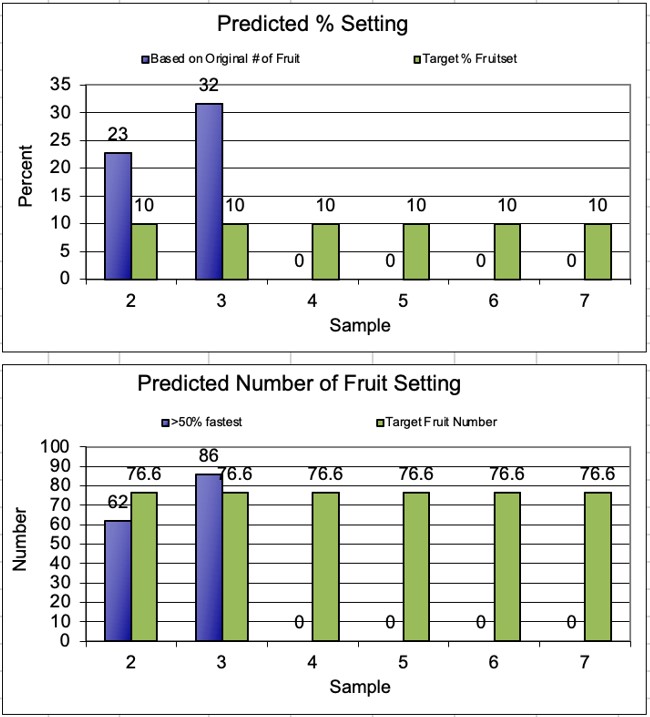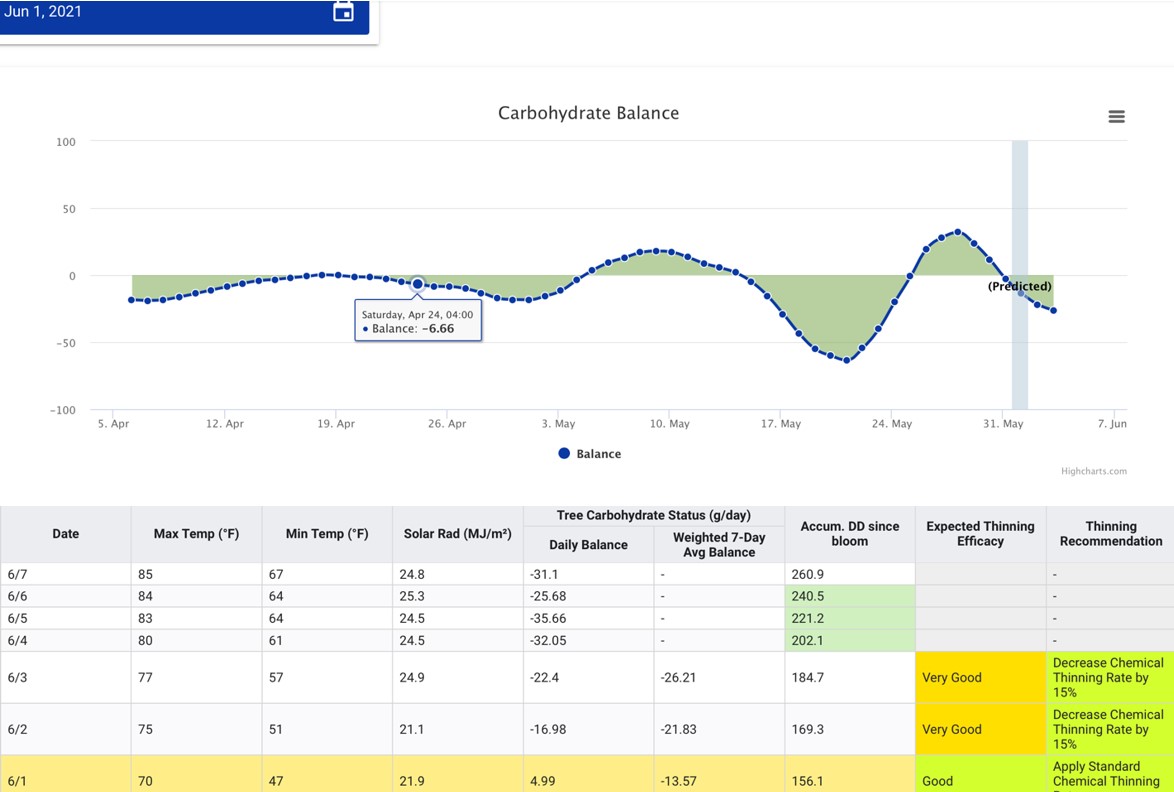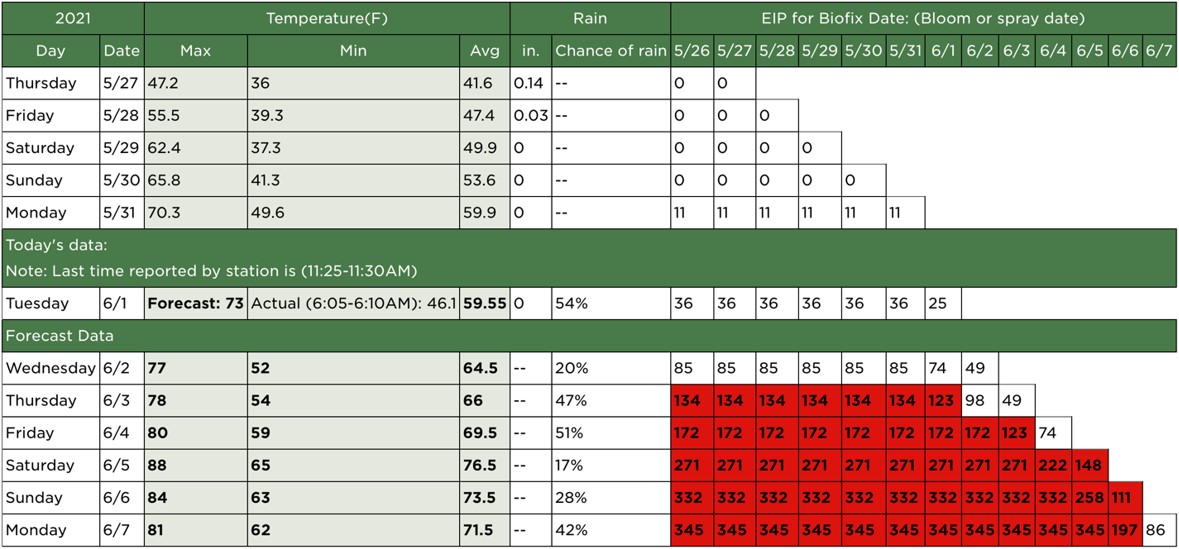Northwest Michigan fruit update – June 1, 2021
With the forecasted warm weather, apple growers are concentrating on thinning and cherry growers are continuing to cover new tissue for fungal diseases.

Weather report
The daytime weather seemed more summer-like as the weekend progressed, but we still had some freezing temperatures in isolated areas over the past few nights/early mornings. Growers are concentrating on thinning apples. The dry weather has minimized the concerns of disease development, but we did have trace amounts of rainfall mid-week last week (May 25-27). For 2021, we have accumulated 695 growing degree days (GDD) base 42 and 357 GDD base 50. These accumulations are slightly higher than our 31-year average of 627 GDD base 42 and 319 GDD base 50.
According to Michigan State University state climatologist Jeff Andresen, the weather will continue to be fair, dry and seasonably warm. There is a chance of isolated showers this evening and potential thunderstorms on Wednesday evening into Thursday (June 2-3). However, Andresen says the best chances for rain are in southeast Michigan.
As we approach the weekend, conditions are predicted to be warmer and dryer. The daytime temperatures will be very summer-like as they are forecasted to be in the 80s and even approaching the 90s. There is little rainfall predicted in the region, and we could use the rain as soils are continuing to dry out with the dry conditions in recent weeks. The medium range forecast is predicting more warm weather with dry conditions for the remainder of the week into next week.
Crop report
The dry conditions have helped growers with controlling fungal diseases. However, we did have small amounts of rainfall that triggered apple scab and leaf spot infections. Most growers have been covering up with the increased new growth and spotty rainfall in the past week. Apple growers are concentrating on thinning at this time. We have been measuring fruitlets using the FruitSet Model. At the Northwest Michigan Horticulture Research Center, we have thinned the Galas based on this model (over the weekend, Figure 1) but did not thin the Honeycrisp as these trees have less of a fruitset (or freeze damage), so we will not need to thin this crop (Figure 2). We will measure the Gala crop again tomorrow (June 2) to know if we will need to apply a second thinner application.

The FruitSet Model is based on the concept that fruitlets whose growth is slowing (growing at less than 50% of the fastest growth rates) will abscise, while others will set and remain on the tree. To determine which/how many fruitlets are actively growing and which will abscise, measurements are taken at three and eight days after thinning applications are made. Originally, this was conducted by tagging clusters and using calipers to measure pre-marked fruitlets, but new technologies using computer vision are being developed to make this process easier (not yet available).
This model is available as an Excel spreadsheet downloadable in the MSU Extension article website, “Updated apple cropload management models are available.”
This model keeps track of measurements of fruitlet growth and predicts set. We suggested that between 20 to 100 (40 is probably adequate) representative flower clusters should be marked and diameter measured every three to four days. The diameter growth will be used to predict fruitlet abscission. All fruit that slow to a growth rate of 50% or less of the growth rate of the fastest growing fruit, will ultimately stop growth and abscise.
The carbohydrate model for the Northwest Michigan Horticulture Research Center is changing with the current weather forecast. The temperatures are predicted to be warmer in the coming days, which will impact thinner activity. The model is predicted to reduce the thinning rate by 15% as a result of this pending weather (Figure 3). The carbohydrate model is predicting a negative balance beginning today but also later in the week when the daytime temperatures reach into the mid-80s. If growers have not yet thinned, they should apply thinners as soon as they are able.

Growers can access the carbohydrate model at one of the following sites:
Pest report
Diseases
With the dry weather, we have not had a new apple scab infection period since May 21 (Figure 4).

RIMpro model outputs are also available for monitoring apple scab:
Fire blight. Most orchards are past bloom, perhaps some cider apple orchards are still blooming or orchards further north or later blooming varieties. For the most part, apple orchards are finished with bloom. The following figure (Figure 5) does indicate that the EIP will be high with the high daytime temperatures, so growers that still have some bloom in the orchard should apply an antibiotic spray.

MSU is still recommending Apogee applications for minimizing shoot growth and for fire blight control. We have had issues with shoot blight in recent years, and growers that did not use Apogee had serious infections with the good growth and windy/rainy weather in early spring. Please read the MSU Extension article, “Applying Apogee and Actigard to young apple trees,” for more information on helping control fire blight but still achieving good growth on newly planted apple trees.
The cherry leaf spot model predicted an infection period on May 25 (Figure 6). With little rain in the forecast, monitor the weather for pop-up showers to cover new tissue.

Insects
The warmer and alternately colder weather has been a stop/start to insect activity. Growers should be on top of the insecticide programs because of the weird weather and random insect activity.
The numbers of American plum borer adults have decreased this week. We caught an average of about five moths this week compared to an average of about 16 moths last week. We also caught one lesser peach tree borer this week.
Our oriental fruit month numbers are up similar to last week. We caught an average of about two moths this week compared to about three moths last week. This pest has not typically been a huge problem in northwest Michigan, but growers should keep an eye on as always.
We have caught codling moth in the past two weeks, but numbers have been very low. Codling moth prefer to fly when dusk temperatures are in the 60s. We anticipate the numbers to climb with the weather forecasts to be in the 80s in the daytime and nighttime temperatures to be warmer. Growers should be monitoring codling moth in their blocks as this pest can be problematic in some orchards.
The numbers of male San Jose scale have increase in our traps at the Northwest Michigan Horticulture Research Center and at grower farms this week. We caught an average of about 23 San Jose scale males this week compared to an average of four males last week. The San Jose scale model is predicting to apply insecticide applications for crawlers now, but we are recommending growers wait at least one week as we are just starting to see male flight increase this week. Growers should make applications at the end of this week or the start of next week in sweet cherry.



 Print
Print Email
Email
